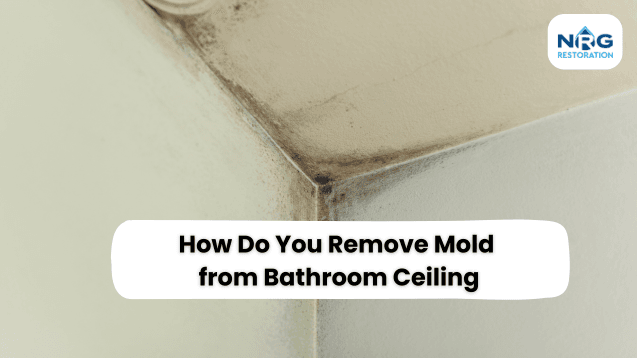Still scrubbing at ceiling mold with vinegar and hope?
Mold is not just a health threat, a structural risk, or a warning sign that your home needs help. From bathroom mold to flood damage, we don’t clean, we restore.
What natural solutions work best for bathroom ceiling mold?
If you prefer avoiding strong chemicals, there are natural methods that can clean mold effectively. These methods are safe, affordable, and easy to try at home.
- Vinegar – White vinegar kills most types of mold and is safe for ceilings. Spray directly and let it sit before scrubbing.
- Baking soda – Mixed with water, it forms a paste that removes stains and deodorizes.
- Hydrogen peroxide – Works as a disinfectant and removes mold spores from porous surfaces.
- Tea tree oil – Though more expensive, it is powerful against mold growth.
Using these options regularly can help control mold naturally.
How do you safely apply natural cleaners to the ceiling?
It’s important to clean mold safely, even with natural products. Without care, spores can spread into the air.
Follow these steps for safe cleaning:
- Protect yourself – Wear gloves, goggles, and a mask to avoid breathing in spores.
- Ventilate – Open windows or run a fan to keep air moving.
- Apply cleaner – Spray or dab your chosen solution on the mold patch.
- Scrub gently – Use a soft brush or cloth to avoid damaging paint or plaster.
- Dry completely – Mold can return quickly if the area stays damp.
Taking these precautions keeps you safe and helps the cleaning work better.
Can natural methods remove mold stains completely?
One concern people have is whether stains disappear fully. Natural cleaners often remove the mold itself, but stains can remain. For light stains, vinegar or hydrogen peroxide usually works well.
For tougher stains, you may need:
- Repeated cleaning – Applying vinegar or baking soda more than once.
- Repainting – Using mold-resistant paint after cleaning.
- Professional help – When stains indicate deep mold growth.
So while natural cleaners are effective, some cases may need more than surface treatment.
How do you remove mold from bathroom ceiling permanently?
This is the big question how do you remove mold from bathroom ceiling so it never returns? The answer lies in fixing the root causes.
Here are long-term steps:
- Improve ventilation – Use exhaust fans or open windows to reduce moisture.
- Fix leaks – Even small ceiling leaks can feed mold.
- Control humidity – Use a dehumidifier to keep air dry.
- Regular cleaning – Wipe down ceilings and corners after showers.
Without these steps, mold often comes back even after cleaning.
When should you avoid DIY mold removal?
Not every mold problem can be handled with natural methods. If the mold is too widespread or keeps coming back, DIY cleaning may not be enough.
You should avoid DIY if:
- The mold covers a large area of the ceiling.
- You notice black mold or toxic-looking patches.
- Family members are experiencing allergies or breathing issues.
- The mold is linked to water damage or leaks in walls.
In these cases, professional treatment is safer and more effective.
How can professionals help with bathroom ceiling mold?
Experts have tools and knowledge that go beyond natural cleaning methods. If you’ve tried everything and the mold keeps returning, professional help ensures it is removed completely.
Professional services provide:
- Inspection – Finding hidden mold inside walls and ceilings.
- Safe removal – Using equipment that prevents spores from spreading.
- Repairs – Fixing leaks or damage that cause mold.
- Prevention – Applying treatments to stop mold from growing again.
This is where NRG Restoration can help. Our team specializes in safe mold removal and makes sure your home is healthy again.
How can you prevent mold from coming back after cleaning?
Prevention is the key to a mold-free bathroom. After cleaning, it’s important to maintain good habits.
Some prevention tips include:
- Run an exhaust fan during showers – Removes steam before it settles.
- Wipe down tiles and ceilings – Dry surfaces quickly after use.
- Use mold-resistant paint – Gives extra protection to ceilings.
- Keep humidity low – Use a dehumidifier in damp seasons.
With these simple steps, you can stop asking how do you remove mold from bathroom ceiling again and again.
Can mold on bathroom ceilings affect your health?
Yes, even if it looks harmless, ceiling mold can affect your health over time. Mold spores can trigger allergies, asthma attacks, or skin irritation. Children, seniors, and people with weak immune systems are at greater risk.
Breathing in mold spores daily can also lead to:
- Constant sneezing or coughing.
- Red or itchy eyes.
- Headaches and fatigue.
- Breathing discomfort.
Removing mold quickly is important not just for your home but also for your family’s health.
Disasters are personal. So is our help!
Whether it’s water damage soaking your walls, fire damage leaving smoke behind, mold creeping in, or storm chaos tearing through your space, we’re not just contractors. We’re your cleanup crew, rebuild squad, and peace-of-mind providers.
Clean naturally, but know when to call experts
Natural methods can be effective when the mold is small and fresh. Vinegar, baking soda, and hydrogen peroxide are safe ways to treat your ceiling. But if mold is spreading, stubborn, or keeps coming back, you need expert help.
NRG Restoration provides professional mold removal and prevention solutions. Our team ensures that mold is not only cleaned but also stopped from returning.
If you’re tired of asking how do you remove mold from bathroom ceiling and want a lasting solution, reach out to NRG Restoration today. Protect your home, your health, and your peace of mind.
